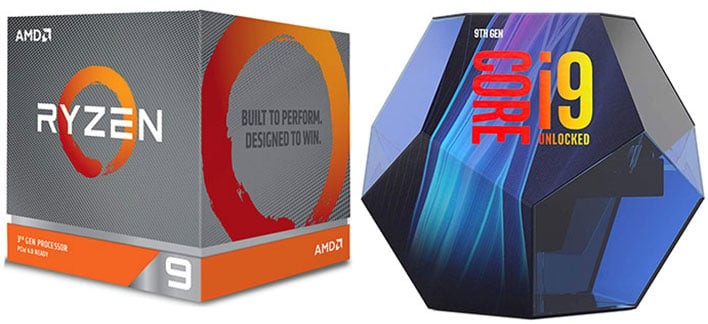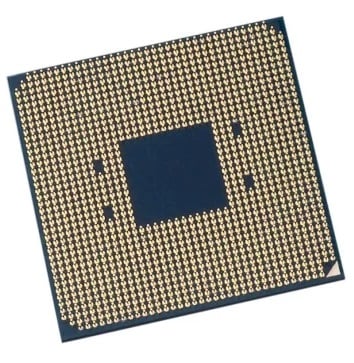AMD renewed competition in the CPU space back in 2017, when its Zen-based Ryzen processors
stormed the scene a couple of months earlier than originally anticipated. These processors combined
good enough single-threaded performance with many core architectures at attractive prices. If you needed king-of-the-hill single thread performance, Intel was still on top, but
Ryzen brought multi-core performance to a price point more palatable to the masses, and were great choices for general purpose workloads and multitasking alike. A year later, second-generation Ryzen CPUs based on the Zen+ architecture brought
more performance per dollar, but the relative pecking order was maintained; AMD still couldn't beat Intel's single-thread performance. That hurt Ryzen in certain gaming scenarios, while multithreaded workloads were AMD's forte. Last month, however, all of that changed when AMD's
Zen 2 CPU architecture arrived.
Suddenly the single-threaded performance of the perennial underdog's CPUs was no longer just
good enough; now it was pretty great. That's in part to somewhat higher clock speeds, but
AMD claimed its new CPUs had a 25% increase in IPC (Instructions Per Cycle) throughput. Certainly, overall performance is stellar, as we surmised in our full review. Thanks to TSMC's 7-nanometer process, the Ryzen 3000 processors have more of everything, including L3 cache, clock speed, and cores. As a result, AMD's latest
3rd Gen Ryzen processors (spoiler alert) got our Editor's Choice award.
Now that the dust has settled, it's time to figure out where these performance improvements originated. AMD's new Ryzen CPUs can clock as high as 4.6GHz, a notable bump over previous models, but what about AMD's purported
IPC gains? Has Zen 2 caught up to Coffee Lake? To test this hypothesis, we fired up our Ryzen 9 3900X and Core i9-9900K test benches again. Both CPUs had their maximum multipliers capped at 40 across all cores, which for both CPUs resulted in a nice, round 4 GHz. The AMD Ryzen 9 3900X we had on hand also had two cores disabled on both of its chiplets, bringing the total core count down from 12 to 8 in a couple of tests, a perfect match to Intel's octal-core Core i9-9900K. This should put both CPU architectures on an even playing field.
 |
|
HotHardware's Test Systems
|
|
Intel vs. AMD at 4 GHz |
|
Of course, you wouldn't run a real system with either of these configurations. The
Intel Core i9-9900K is giving up a full 1 GHz on its maximum turbo boost, and the
Ryzen 9 3900K is giving up 500 MHz, along with four of its cores. As a result, the absolute numbers generated by our test suite aren't intended to represent the complete picture of real world performance. Instead, the relative positioning of the two CPUs will help settle the debate of whether Intel has ceded its single-threaded IPC crown to the challenger AMD or if Chipzilla instead continues to reign supreme. Let's start with some synthetic benchmarks, with SiSoft's SANDRA single-thread processor arithmetic tests.
Detailing The Match-Up
While it's tempting to compare the Ryzen 9 3900X with only eight cores enabled as a proxy for the Ryzen 7 3700X, it's not a valid comparison. Remember that AMD packs two chiplets into its Ryzen 9 CPUs, and each chiplet has its own 32MB of L3 cache. That means our hamstrung CPU still has a 64MB L3 cache, where the Ryzen 7 3700X gets by with just 32MB. AMD made a big deal about the increased cache sizes when the company unveiled Zen 2 at its E3 event, so it stands to reason that at least part of any IPC gains we see are a direct result of that bigger cache pool. However, by trimming the cores on the 3900X instead of using a 3700X, we get to keep cache levels the same for these two higher-end chips that share relatively similar price points. However, we'll then turn those extra cores back on when we get to the gaming tests, and then we can see exactly what those extra cores bring to the table as well.
 |
|
Synthetic Testing with SiSoft SANDRA 2020 |
| Dhrystone and Whetstone Tests |
|
We began our testing with the latest version of SiSoftware's SANDRA 2020, or
System ANalyzer, Diagnostic and Reporting Assistant. We stuck to the single-threaded CPU tests for this round, since the other (like the memory subsystem) tests should be affected minimally by our special configuration.
Right off the bat, performance is evenly split between the hamstrung CPUs. Intel takes the cake in the Dhrystone Integer and Long AVX2 tests. The Integer test gave Intel around a 6% lead, where the Long (64-bit integer) test gives Intel a 10% advantage. The floating point-intensive Whetstone tests, which also use AVX when available, gave AMD wins in the 4 to 6% range. We already knew AMD's AVX unit was
greatly enhanced for Zen 2, and SANDRA bears that out.
 |
|
Geekbench |
|
Synthetic CPU Testing |
|
In this round of
Geekbench testing, we're stressing a single CPU core only, and, just like with SANDRA not particularly interested in the other memory subsystem tests.
This time out the CPUs are almost perfectly matched. Intel holds a slight lead, but well within what we would consider the margin of error for
Geekbench. That 15-point difference is a quarter of a percent, so we'll call it a tie. That tracks well with the Core i9-9900K's 4% single-threaded lead when the CPUs were unrestrained.
Let's look at some single-threaded number crunching, next...
 |
| Geekbench |
| Synthetic CPU Testing |
|
 |
| Geekbench |
| Synthetic CPU Testing |
|















